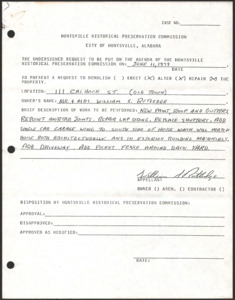
Browse Items (6217 total)
Sort by:
-
Dr. Konrad Dannenberg (Space History Interviews).
Interview by Dr. Donald Tarter as part of the UAH M. Louis Salmon Library's Space History Interviews. Due to the age of the interview and the fact that it was originally stored as a lower quality WMV, it will not be pristine.Tags Oral History -
Architecture notebook 10: Rutledge residence, 111 Calhoun St., Huntsville, Ala.
Documentation of plans to alter the residence at 111 Calhoun St. in Huntsville's Old Town, submitted to the Huntsville Historical Preservation Committee, 1979. Includes drawings and photographs of the structure and property before and after the alterations. -
World War I diary of Archie Duncan Shannon.
Archie Shannon was a farmer who served in Company G of the 1st Pioneer Infantry in World War I. Shannon was born in Limestone County, Alabama on November 19, 1891, and at the time of his draft registration on June 5, 1917, he lived in Ardmore, Tennessee. Shannon reported for military duty on September 18, 1917 and entered training at Camp Pike, Arkansas.
This diary covers Shannon's experiences in the U.S. Army from July 1, 1918 to July 7, 1919. He describes his journey to France and details everyday life as a soldier, especially the discomforts of life on the front in both the Marne and Verdun sectors. Shannon discusses bathing and sleeping arrangements, gas masks, air raids, and the terrible sights of war-torn France while repairing roads and burying dead soldiers. Shannon includes descriptions of his involvement in the Meuse-Argonne Offensive, noting the continuous shelling, gas attacks, and miserable weather conditions. He also describes his company's reaction to the Armistice, writing, "Many happy hearts in our company everyone seems to take life anew."
Shannon spent the rest of his World War I service in Belgium, Luxembourg, and Germany, and he returned to the United States on July 7, 1919. A list of soldier names and hometowns is recorded in the back of the diary. Shannon died on May 20, 1969 and is buried in Gatlin Cemetery in Ardmore, Alabama. -
Transcript of the World War I diary of Archie Duncan Shannon.
Archie Shannon was a farmer who served in Company G of the 1st Pioneer Infantry in World War I. Shannon was born in Limestone County, Alabama on November 19, 1891, and at the time of his draft registration on June 5, 1917, he lived in Ardmore, Tennessee. Shannon reported for military duty on September 18, 1917 and entered training at Camp Pike, Arkansas.
This diary covers Shannon's experiences in the U.S. Army from July 1, 1918 to July 7, 1919. He describes his journey to France and details everyday life as a soldier, especially the discomforts of life on the front in both the Marne and Verdun sectors. Shannon discusses bathing and sleeping arrangements, gas masks, air raids, and the terrible sights of war-torn France while repairing roads and burying dead soldiers. Shannon includes descriptions of his involvement in the Meuse-Argonne Offensive, noting the continuous shelling, gas attacks, and miserable weather conditions. He also describes his company's reaction to the Armistice, writing, "Many happy hearts in our company everyone seems to take life anew."
Shannon spent the rest of his World War I service in Belgium, Luxembourg, and Germany, and he returned to the United States on July 7, 1919. A list of soldier names and hometowns is recorded in the back of the diary. Shannon died on May 20, 1969 and is buried in Gatlin Cemetery in Ardmore, Alabama. -
London Fire Monument.
To memorialize the Great London Fire of 1666, Sir Christopher Wren helped Robert Hooke build this monument near the London Bridge. -
Tower of London tower green.
A field within the Tower of London. This is where nobility was executed, away from the traditional crows. Katherine Howard was one of three queens beheaded here. -
Katherine Howard's letter to Thomas Culpeper
This is the only surviving letter written by Katherine Howard. It is addressed to Thomas Culpeper, whom she was accused of having an affair with. The letter can be interpreted in many different ways, from evidence of the affair to the possibility of Katherine being blackmailed. -
St. Peter's Cornhill.
A picture of St. Peter's Cornhill, a church that Sir Christopher Wren built after the London fire in 1666. -
St. Michael Cornhill.
St. Michael Cornhill is a church that stands on one of the oldest Christian sites in Britian, dating back to Roman occupation. It was rebuilt by Sir Christopher Wren in 1672 after the London Fire in 1666. The tower was built by Nicholas Hawksmoor in 1722. It was later restored by Sir George Gilbert Scott in 1860. -
St. Mary Woolnoth.
St. Mary Woolnoth is one of the churches rebuilt after the London Fire. It had partly survived the fire but after considerable repairs in 1670, it was determined that it needed to be rebuilt in the 18th century. While this one is traditionally credited to Hawksmoor, it was rebuilt by the Commision that rebuilt about 50 churches in London, which Sir Christopher Wren is usually credited.









